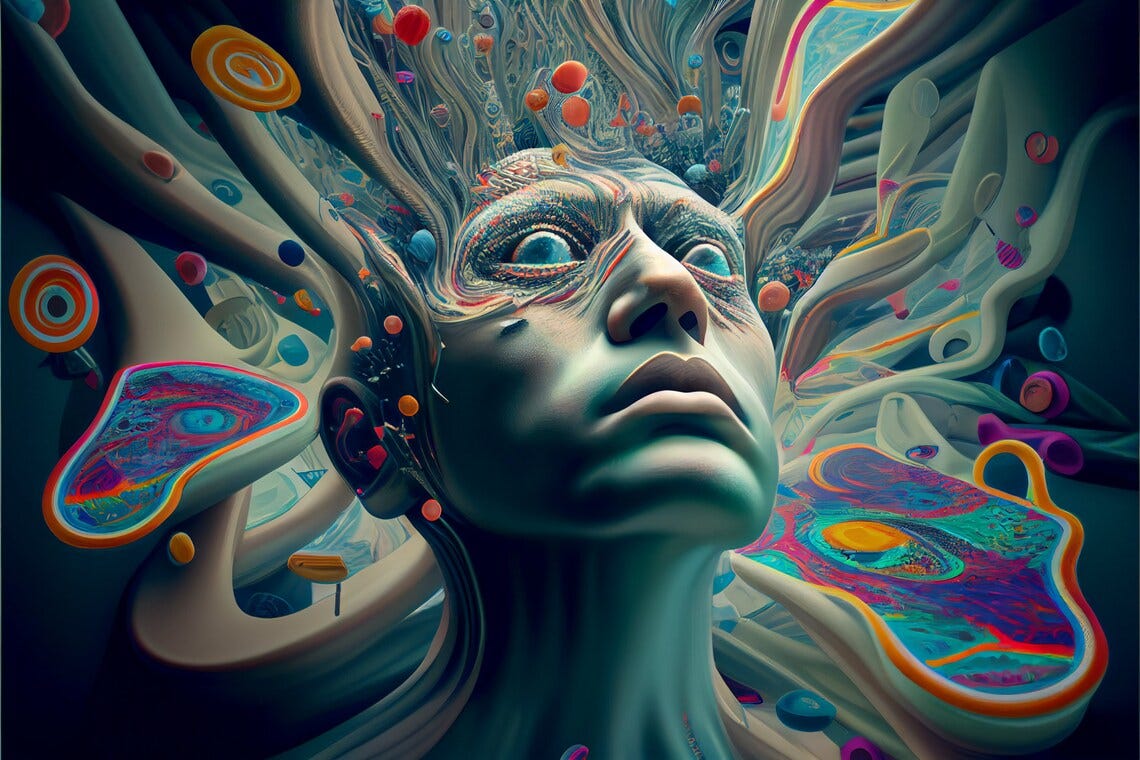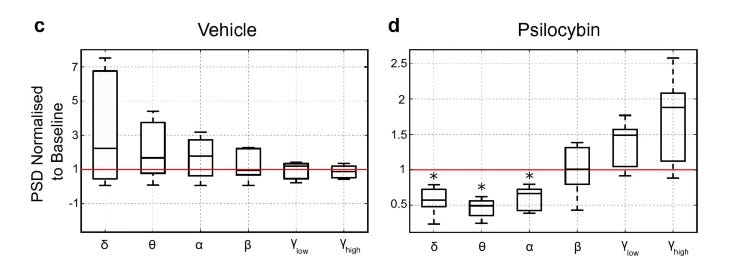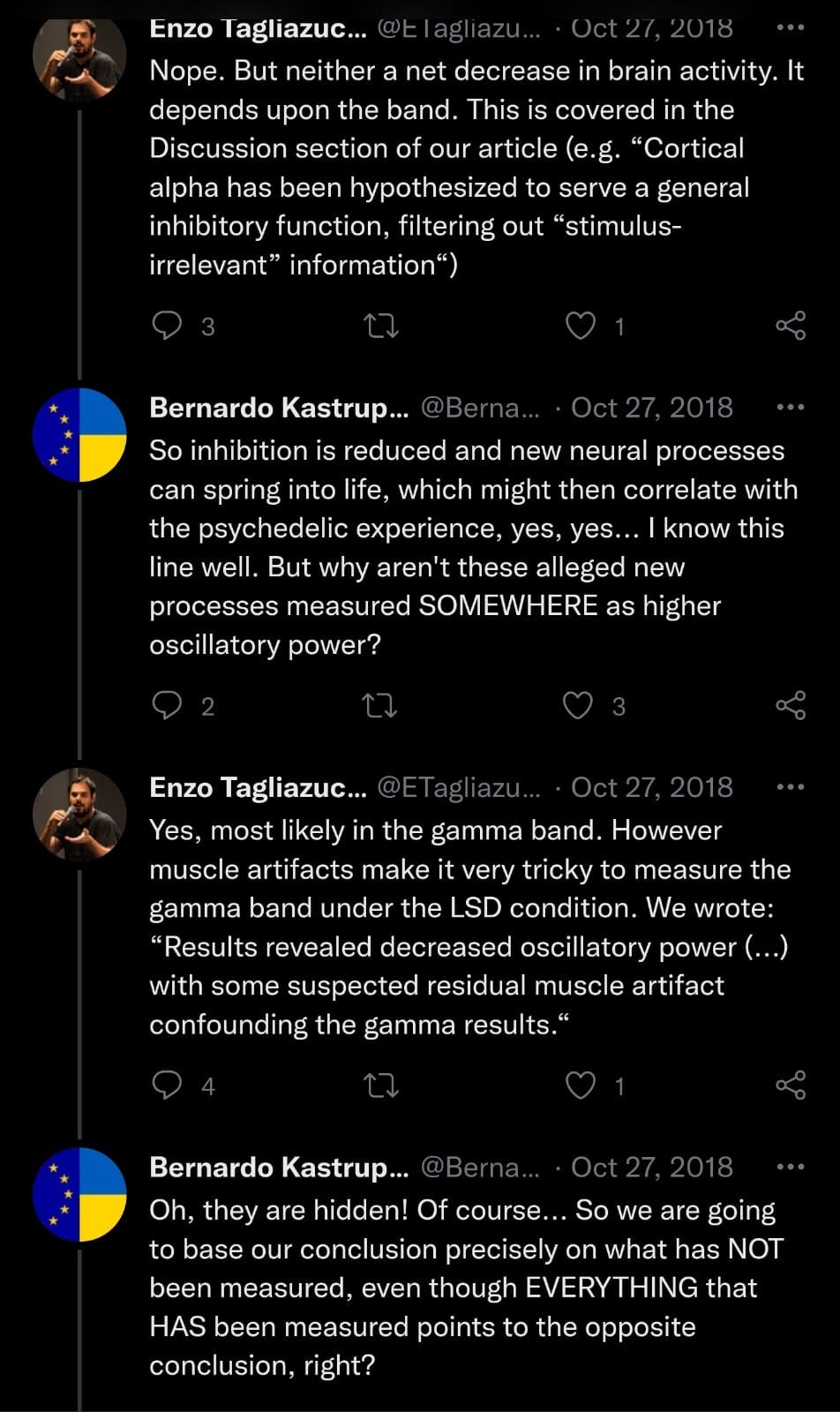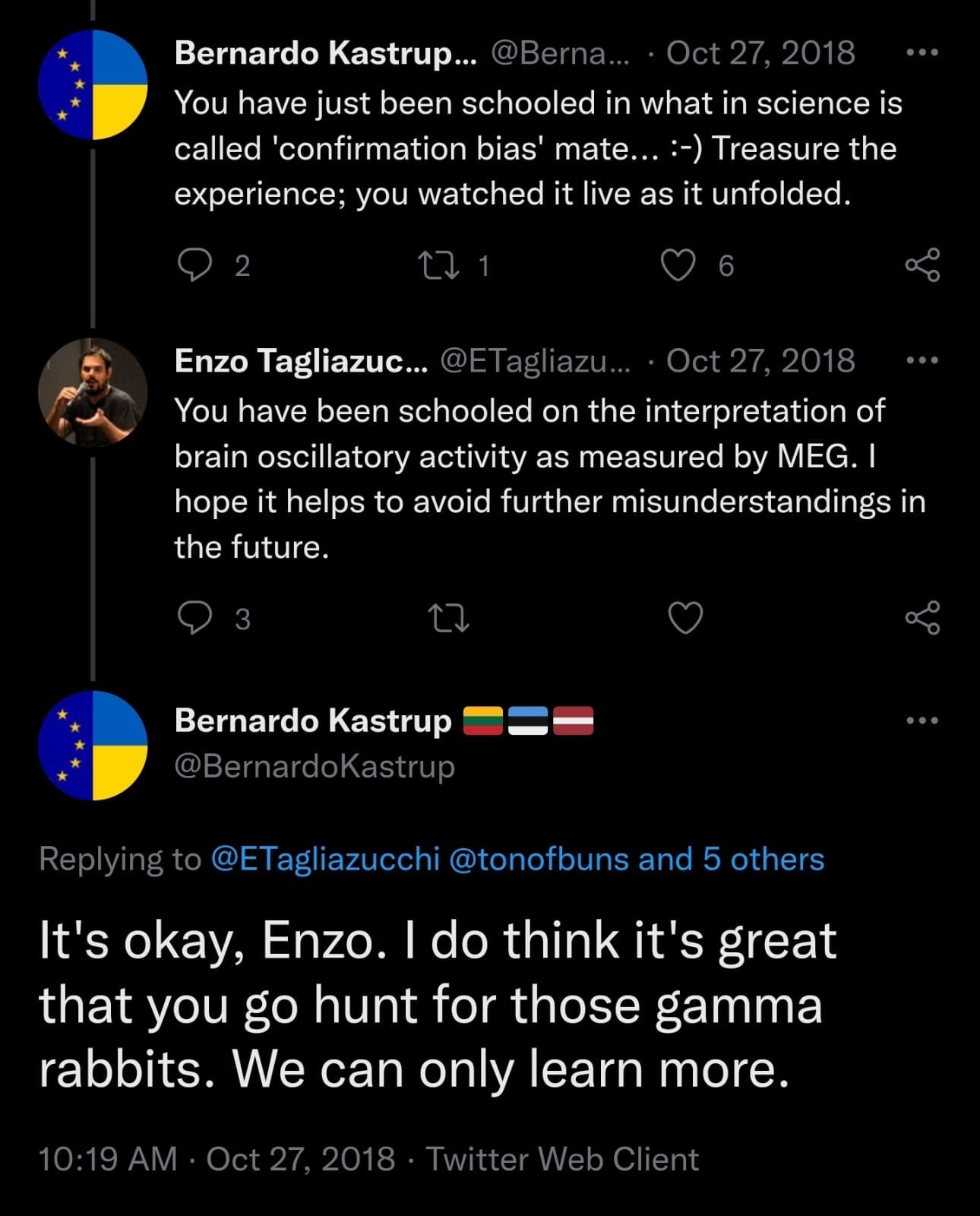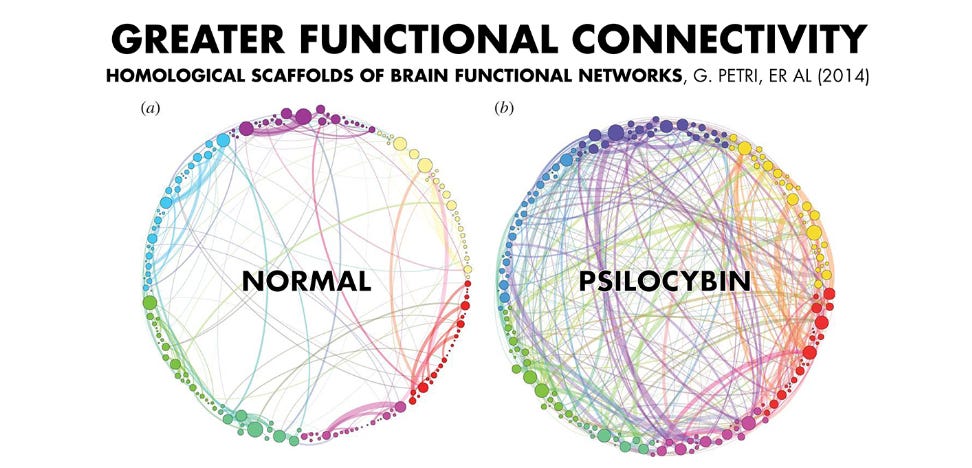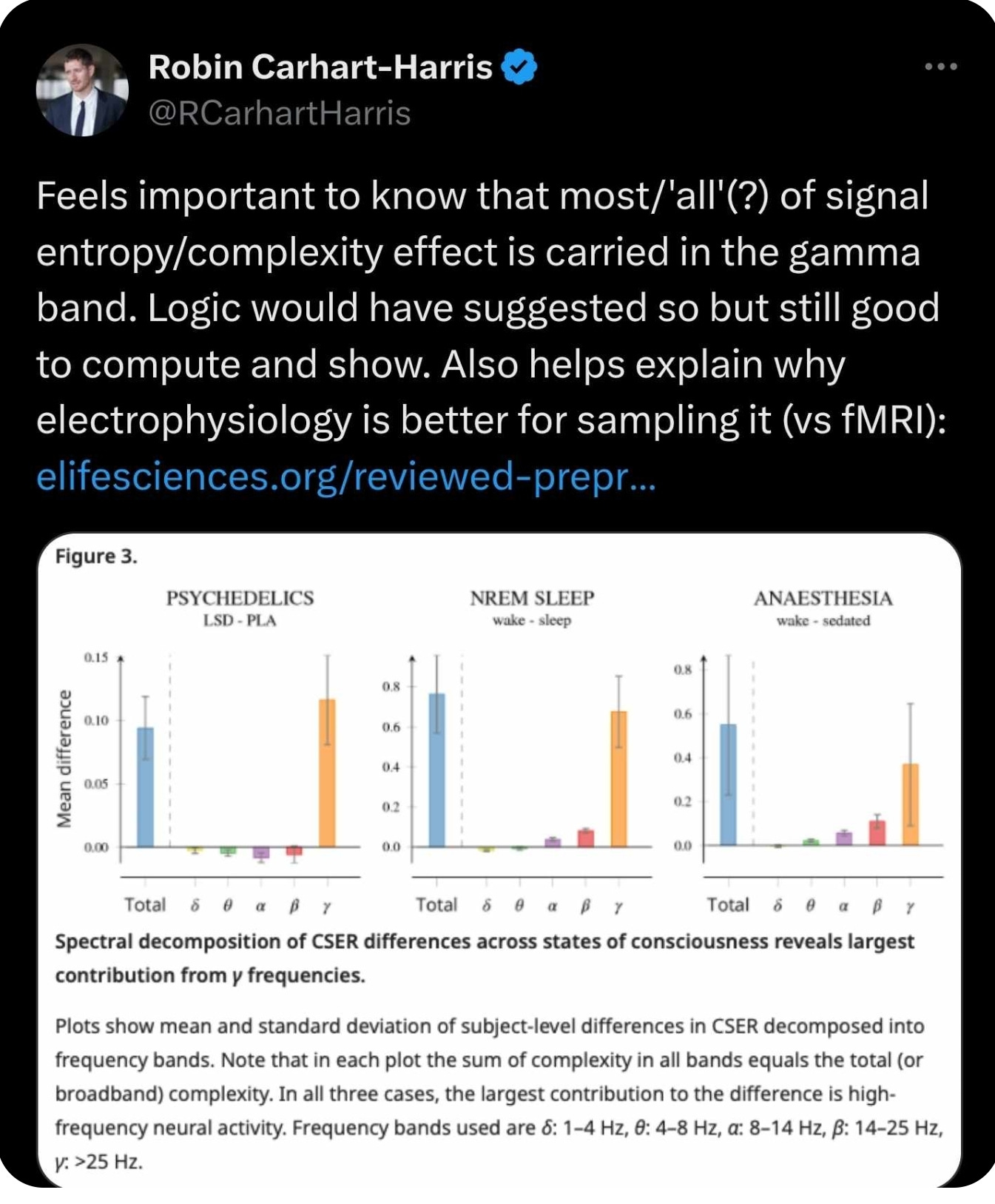Alcohol, Psychedelics, and Idealism of the Brain
Emerging Narratives Abound
Billions of people across the world consume alcohol in various forms everyday. The vaunted “happy hour” is taking place right now somewhere on the planet and people are exposing themselves to this elixir that affects their conscious experience. Many people claim to enjoy the subduing effects of alcohol with its ability to “take the edge off”. Too much alcohol and the effects of cognitive impairment, disinhibition, and severe loss of coordination arise. While psychedelics are experiencing a resurgence in interest, they are consumed by a tiny percentage of the population by comparison. Nevertheless, the effects of these psychoactive compounds can be quite profound coinciding with the expansion of one’s conscious experience, enhanced cognition, increased introspection, and an increased feeling of aliveness.
In many ways, alcohol and psychedelics are generally considered to be the antithesis of each other.
Alcohol has depressant effects while psychedelics are quickly emerging as significant antidepressant molecules. The effects of both substances on neurogenesis (the generation of new neurons) are also the polar opposites with alcohol having a suppressive effect while psychedelics have an upregulating effect. Alcohol has also shown to have a vasodilatory effect coinciding with an increase in blood flow. By contrast, psychedelics have displayed the opposite with their vasoconstrictive properties inducing a decrease in blood flow.
The list could go on and on regarding the opposite effects of alcohol and psychedelics both acutely and long-term.
The question is whether these perceived opposite effects would also be reflected in brain activity measured via various scientific instruments. There are two forms of neuroimaging technology utilized to measure brain activity… direct (electrical) and indirect (metabolic). Direct is self-explanatory as it measures the electrical activity of neuronal communication every millisecond in the brain via electroencephalogram (EEG) in real-time. This type of measurement is considered temporal because it measures precisely when brain activity happens coinciding with an experience. Indirect is the utilization of proxies for neuronal communication such as glucose metabolism (PET), blood flow and blood oxygenation changes (fMRI). PET and fMRI are considered to be spatial meaning that their measurements give insight as to which area of the brain is active.
EEG technology utilizes electrodes placed on the scalp of the head and measures the electrical activity of neuronal communication. In layman’s terms, the end result of these measurements are referred to as “brain waves”. Generally speaking a person’s dominant brain waves tend to mirror their state of consciousness changing based on the immersiveness and intensity of an experience. During non-REM sleep and general anesthesia, a person’s brain waves are at their slowest known as delta which average between 0.5 to 4 oscillations per second. Delta waves are followed by theta (4 to 8 Hz), alpha (8 to 12 Hz), beta (12 to 35 Hz), and gamma/high gamma range (35 to 150 Hz). It is generally considered that as brain waves increase in speed, the complexity of mental tasks, sensory perception, selective attention, and speed of information processing increases. While the EEG activity of humans and rats are similar based on their neurological activity when exposed to environmental exposure or pharmacology, there are slight interspecies differences.
A 2004 study published in the Journal of Studies on Alcohol observed that alpha wave power increased following the ingestion of alcohol. An additional increase in theta waves and a decrease in beta waves were found with greater ingestion of alcohol. These findings have been consistent across multiple studies (Ehlers and Phillips, 2003; Ehlers et al., 1999, Wall et al., 1993) and correspond with the sensation of drowsiness, disinhibition, and mental impairment induced by alcohol. A 2021 meta-analysis paper in the Journal of Personalized Medicine cites data indicating that the suppression of gamma waves is linearly related to the amount of alcohol consumed. The more alcohol ingested, the greater the suppression of gamma waves. This also coincides with the experience of cognitive impairment in a dose dependent manner.
A 2016 human EEG study observed that psilocybin decreased alpha power while inducing a simultaneous increase in gamma power. A 2022 rodent intracranial EEG study found similar findings following psilocybin administration with a suppression of slower brain waves while seeing a significant increase in the faster gamma waves. These results have been replicated by an unrelated lab at the University of Michigan (Silverstein et. al, 2024). Intracranial EEG is considered to offer artifact-free brainwave signaling due to the electrodes being implanted within the brain rather than sitting atop the skull. Similar EEG data has been observed in multiple human and animal studies involving Ayahuasca (Don et al., 1998; Stuckey et al., 2005; Schenberg et al., 2015; Tagliazucchi et. al, 2021), DMT (Acosta-Urquidi, 2015; Pallavicini et al., 2021; Timmerman et al., 2023; Glynos et al., 2024), 5-MEO-DMT (Acosta-Urquidi, 2015; Riga et al., 2018;) psilocybin (Pal et al., 2024), LSD (Goda et al., 2013; Brys et. al, 2023), & Ibogaine (Gonzalez et al., 2021). Some of these studies showcase an increase in both gamma and delta/theta bandwidths simultaneously (cross-frequency coupling) similarly to what has been observed in meditation (Cahn et. al, 2011; Lutz et. al, 2004; Braboszcz et. al, 2017), rapid eye movement REM sleep (Buzsaki et. al, 2008; Scheffzuk et. al, 2011; Mishra et. al, 2019; Hammer et. al, 2023), and breathing exercises (Jensen et. al, 2002; Viallate et. al, 2009; Kozhevnikov et. al, 2013; Bahi et. al, 2023). The fact that a combined 15 human and intracranial animal psychedelic studies from 11 different research teams have shown consistent results indicates that alpha suppression and gamma increase is an established electrical signature for psychedelics.
(One of the world’s leading EEG experts, Jay Gunkelman has clearly stated in his various lectures that the gamma wave is essential to understanding states of consciousness. This is a man that has seen upwards of 500,000 raw EEG readings throughout his career and has written the book titled, “The Art of Artifacting”. In this book Gunkleman outlines the art of editing out artifacts from raw EEG signals. Making the claim that the gamma frequency is difficult to differentiate between muscle artifact and brain activity seems to be more based on dogma due to the inexperience of many researchers regarding analyzing raw EEG. Being that Gunkelman learned to read EEG prior to the digitization of the field, it would seem to contribute to his expertise compared to the majority of researchers today that rely on software for raw data interpretation.)
(Figure 1C from the 2022 Intracranial EEG Animal Study. The brain waves are arranged in speed from slowest (delta) on the left to fastest (high gamma) on the right. Vehicle is the effects of saline injection. Psilocybin shows a clear increase of faster oscillations.)
There seems to be a relatively consistent inverse EEG signature between alcohol and psychedelics in both human and animal studies. There is a consistent increase in alpha power and a decrease in gamma following alcohol ingestion while psychedelics induce a significant suppression of alpha and an increase in gamma. None of this seems entirely surprising being that the substances induce vastly different effects and states of consciousness.
Positron Emission Tomography (PET) is a highly sensitive type of brain imaging that utilizes radioactive substances to measure metabolic changes taking place at the cellular level in the brain. PET offers spatial imaging and can identify where glucose is being utilized in the brain which is a measure of metabolism. A 2006 human PET study in the journal Neuroimage cites evidence indicating that alcohol decreases whole-brain glucose metabolism by up to 23% in a dose-dependent manner. This finding has been replicated in both animal and human studies (Volkov et. al, 2013, Wang et. al, 2003, Gispert et. al, 2017). By contrast, a 1997 human PET study in the journal Neuropsychopharmacology cites data indicating that 15 to 20 mg of psilocybin increases whole-brain glucose metabolism by up to 25%. Similar results have been replicated in a follow up study (Vollenweider et. al, 1998) as well as amongst a different research team (Gouzoulis-Mayfrank et. al, 1999). This comes as no surprise being that multiple studies highlight the finding of increased glucose metabolism being essential for increases in gamma wave amplitude (Galow et. al, 2014; Nishida et. al, 2008; Dienel, 2018). Once again, this shows an inverse relationship between the effects of alcohol and psilocybin on neural activity from the metric of glucose metabolism.
(Figure 3. from the 1997 human PET-Psilocybin study. Red > Orange > Yellow > Green = lowest value of cerebral metabolic rate of glucose. A 25% increase in whole-brain glucose metabolism was measured.)
Functional magnetic resonance imaging (fMRI) is a form of imaging that utilizes strong magnetic fields, magnetic field gradients, and radio waves to generate images of the brain and body. fMRI measures changes in brain activity based on changes associated with blood flow and does not use radioactive substances. Much like PET, fMRI is considered to offer superior spatial resolution in comparison to EEG. A 2011 fMRI human study in the journal Alcoholism: Clinical and Experimental Research provides data indicating that alcohol increases cerebral blood flow in 5 frontal regions of the brain. Similar results have been reported from other research teams (Marinkovic et. al, 2013; Gunderson et. al, 2012). By contrast, a 2012 fMRI human study in the journal Proceedings of the National Academy of Sciences presents data showing that psilocybin induced decreases in cerebral blood flow throughout the brain. These findings have been replicated with LSD (Carhart-Harris et. al, 2016) and Ayahuasca (Palhano-Fontes et. al, 2015). This is yet another example of an inverse relationship between alcohol and psychedelics based on fMRI imaging. However, the results are a bit confounding as one might presume that if fMRI measurements offer insights into neural activity, one would expect a mirroring of increased glucose metabolism and enhanced faster neural activity (gamma) by seeing an increase in blood flow. We speculate that there is likely an uncoupling of fMRI signaling related to certain neural activity taking place which we will touch upon in a bit.
The reason for citing these research studies regarding alcohol and psychedelics is to highlight the fact that these substances which induce what could be considered opposite experiential effects also exert very distinct changes in brain activity. Both substances bring about reliable, measurable changes compared to placebo. To make the claim that one of the substances only reduces brain activity or increases brain activity would be incorrect based on all the available data to date.
This is an issue when narratives propagate based on a small subset of data that does not look at the total body of scientific evidence available on pubmed. This is not a personal attack on the propagator of this narrative (Bernardo Kastrup) but rather pointing out the data that has not been A) considered when propagating this narrative or B) outright ignored due to inducing an incongruence with the desired narrative.
Kastrup has very publicly declared his perspective regarding reality being based on the philosophical notion of idealism. This is the concept that consciousness is primary and the material world, our bodies, and everything within it is a by-product of consciousness. This piece has no issue with that framework as everyone is entitled to their perspective. The issue we are bringing to light is that Kastrup claims that there is a fundamental disconnect between brain activity, experience, and various altered states including psychedelics. He specifically states that psychedelics only reduce brain activity and based upon the rich experience following the ingestion of these compounds, the argument for materialism subsequently falls apart. He openly acknowledges that his evidence is based on a few psychedelic studies generated primarily by Imperial College about a decade ago to support his argument. We must remind scientifically-minded analysts that one research team at one college does not represent all scientific data of a specific field particularly when their data fails to match the consistency of many other unconnected research teams. This is especially in light of this same research team (Imperial) later finding the same EEG-based consistencies seen replicated amongst the majority of psychedelic researchers in years prior (Pallavicini et al., 2021; Timmerman et al., 2023).
Just to be clear, this post isn’t in support of the idea of materialism either. We are strictly focused on technical accuracies and pointing out inaccuracies occurring in certain narratives pertaining to altered states. We are well aware of similar biases of scientists in the field of neurophysiology who are married to the notion that consciousness emerges from brain activity and that one’s consciousness is confined solely within the physical confines of the brain. This is in light of consistent observations of a person’s consciousness reportedly expanding past the barrier of their bodies during moments of transcendence such as near death experiences (NDEs) or consciously induced altered states.
Back to the topic at hand.
In Kastrup’s blog post titled, “Setting the Record Straight with Robin Carhart-Harris and Enzo Tagliazucchi”, he outlined his Twitter and e-mail correspondence with the scientists regarding their psychedelic research. Much of the discourse surrounds interpretation of fMRI data but EEG was also discussed:
These statements allude to the notion that if the study being referred to had seen an increase in gamma waves (like the majority of all other psychedelic studies), that it would provide a measurable correlation with the psychedelic experience. Since that Twitter feud with Kastrup, Enzo Tagliazucchi has authored and co-authored 3 papers showing this effect. Being that faster oscillatory activity is well known to coincide with an increase in the intensity and complexity of an experience, this should come as no surprise. A 2020 study in Frontiers in Human Neuroscience found that high gamma (50 to 80 Hz) is closely related to emotional processing. Being that the acute effect of psychedelics has been observed to significantly increase emotional empathy (Pokorny et. al, 2017; Dolder et. al, 2016), we would presume that a measurable change would take place at this frequency following administration. Unfortunately most psychedelic EEG research fails to measure for oscillations above 45 Hz.
An important aspect to take into consideration is that we must remain cognizant of the fact that direct measurement generally takes precedence over indirect measurement regarding biological function. Direct measurement regarding psychedelic related data would be based on electrophysiological activity of the brain based on neuronal discharge. By contrast, glucose metabolism imaging and blood-oxygen-level-dependent (BOLD) signaling are proxies for neuronal discharge which is an indirect measurement. This is especially in light of the major confounding factors when it comes to the uncoupling of fMRI BOLD signaling as an accurate marker of neural activity.
A 2023 animal study in the Journal of Nuclear Medicine utilized a combination of PET & fMRI simultaneously to measure the effects of MDMA. The researchers found that an increase in glucose metabolism (PET) was accompanied by a decrease in brain blood flow (fMRI). The researchers state that increased neuronal activity from MDMA is accompanied by neurovascular uncoupling. They state that this warrants a reassessment of previous studies on the neuronal effects of psychedelics relying on neurovascular coupling. These findings essentially mirror the psilocybin PET and fMRI data (Vollenweider et. al, 1997; Carhart-Harris et. al, 2012) indicating that there is a significant underlying disconnect between neural activity and fMRI data interpretation pertaining to psychedelics.
A 2021 human study in the Proceedings of the National Academy of Sciences utilizing simultaneous PET and fMRI measurement observed a dissociation between BOLD signaling and glucose metabolism in the default mode network (DMN). The researchers found that a decrease in BOLD response during task occurred while glucose metabolism stayed elevated and increased in certain areas of the DMN.
Another example of uncoupling of fMRI BOLD signaling with neural activity is a 2023 study in the Journal of Neuroscience which also utilized simultaneous measurement of PET and fMRI in humans. The study was designed to decipher the differences in neural activity of working memory tasks in young adults (ages 20-37) compared to older adults (ages 65-86). Much like many other studies, older adults exuded an overactivation of BOLD signaling compared to their younger counterparts. However, for the older adults, there was no corresponding increase in glucose metabolism. The researchers state that the BOLD signal overactivations do not appear to be neural in origin and that caution must be taken when assuming that vascular signals accurately reflect neuronal activity.
We suspect that the major factor leading to the disconnect between blood flow (fMRI) and glucose metabolism (PET) is based on aerobic glycolysis. This is when the neurons predominantly rely on glucose for metabolism despite the presence of adequate oxygen. This would in theory explain the discrepancies between the consistent increases in glucose metabolism coinciding with neural activation while seeing simultaneous decreases in BOLD signaling due to a lack of parallel increase in oxygen consumption. It’s been cited that norepinephrine (NE) stimulates glycolytic activity (Dienel et. al, 2016) and psilocybin has been observed to increase NE synthesis in the brain (Jahanabadi et. al, 2023). The increased gamma wave amplitude and its relationship to increased glucose uptake has also been observed (Galow et. al, 2014; Nishida et. al, 2008; Dienel, 2018). Glycolysis has been identified as a key factor pertaining to neuroplasticity (Shannon et. al, 2016), an effect consistently observed following psychedelic administration. Glycolytic activity has been shown to decrease with age (Goyal et. al, 2023) as does gamma wave power (Murty et. al, 2020) providing some insights as to the overactivation of fMRI BOLD signaling without an increase in glucose metabolism in the elderly. A 2024 psilocybin-fMRI study found that hyper-connectivity was observed to coincide with the BOLD signal reduction. This should come as no surprise being that gamma waves are essential for connectivity between different brain regions (Guan et. al, 2022). This issue regarding the confounding observation of fMRI BOLD signal uncoupling from neural activation and the effects of glycolysis has been brought to light from various researchers over the past decades (Stiernman et. al, 2021; Schurr, 2018; Schurr et. al, 2022; Schurr, 2024; Hall et. al, 2016; Koush et. al, 2021; Rother et. al, 2002; Ekstrom, 2010).
To be fair, this piece is also critical of the earlier studies published by Robin Carhart-Harris and the Imperial team as they clearly did not have high-quality electrophysiological data to publish. Reporting a decrease in all oscillatory bandwidths following psychedelic administration is a clear indicator that something went wrong with either the data acquisition or analysis. The fMRI neural signaling uncoupling issue is something that seems to be a bigger issue than one might suspect and needs to be sorted out in the future by utilizing simultaneous functional PET imaging and fMRI. The lab of Dr. Franz X. Vollenweider would be an ideal site to carry out this type of research as he published the 1997 PET-Psilocybin study and recently published a 2023 fMRI-Psilocybin study utilizing relative cerebral blood flow (CBF) rather than absolute CBF. We must remember that the field of fMRI research is still relatively young, especially in comparison to that of EEG so it will take time to sort out optimal models of application.
While we understand that Bernardo Kastrup is a champion for the metaphysical view of idealism, this doesn’t allow for the misrepresentation of scientific data to help build the desired narrative. Idealism isn’t the study of how the brain-consciousness interface interacts pertaining to altered states. From what we’ve gathered from Kastrup’s writings is that his form of idealism attempts to point out why the brain doesn’t explain conscious experiences. Mainstream materialist scientists generally avoid public acknowledgement of strange anomalous experiences of altered states let alone attempting to understand the neural correlates. Nevertheless, the risk Kastrup takes by continuing to publicly claim psychedelics only “reduce brain activity” is that the public will cite the studies mentioned above and increase their skepticism of idealism because of it. Once one clear inaccuracy in a narrative is uncovered, it leads the public to question everything about the narrative. In addition, it’s inevitable that future psychedelic research will continue to consistently find faster oscillatory activity and increased metabolism from psychedelic administration… it’s a research field in its infancy. In fact, we believe that the measurement of oscillations above 150 Hz should be targeted for measurement as we believe processing speed is of the essence pertaining to transcendental experiences. A potential emerging technology to do so is named the Dodecanogram (DDG) that builds upon EEG. The developers report being able to measure much faster oscillatory activity including the Terahertz range measuring changes in nanoseconds rather than milliseconds. There even lies the future possibility of integrating the Orch OR theory combining Penrose-Lucas and Stuart Hameroff’s hypothesis regarding quantum processes and microtubules. This is based on the extremely fast oscillations believed to coincide with cytoskeletal dynamics (Hameroff, 2022).
While idealism has its place in the world, when discussing the mechanisms of the brain-consciousness field interface, a scientist named Joachim Keppler has been developing a comprehensive model for the past decade. Keppler proposes the notion that the brain is in constant interaction with an ubiquitous background field called the zero-point field (ZPF). According to Keppler, the brain acts as a read-write head of the ZPF in which it accesses information while also uploading information into this field. He elegantly proposes how distinct changes in neurochemistry and oscillatory fluctuations induce changes in experience based on this model.
If Keppler’s model can be incrementally proven, it could offer deep insights into how information is accessed and where memories come from… possibly not the brain itself!
Based on the information outlined above, it seems that the optimal way to maintain homeostatic function is to ingest the proper amount of alcohol and psychedelics in combination to cancel out the effects of each.
Kykeon sangria anyone?
P.S. - The entropic brain theory has been championed by Robin Carhart-Harris over the past decade. “Entropy is a dimensionless quantity that is used for measuring uncertainty about the state of a system but it can also imply physical qualities, where high entropy is synonymous with high disorder.” - Carhart-Harris. In regards to psychedelics it’s been cited that an increase in brain entropy coincides with the psychedelic experience. In recent times, a study utilized EEG, MEG, & ECoG datasets in humans and monkeys finding that gamma waves are the main driver of neural dynamics complexity change and increased entropy. This is yet another criticism of Carhart-Harris in the sense that it’s already known that faster oscillations coincide with richer sensory experiences. To rename it as entropy only confuses people and allows for false narratives to propagate. In addition, in this tweet by Carhart-Harris, he acknowledges that electrophysiology is better at measuring entropy than fMRI which should come as no surprise being that the psychedelic experience would undoubtedly need temporal measurement to match the experience.



